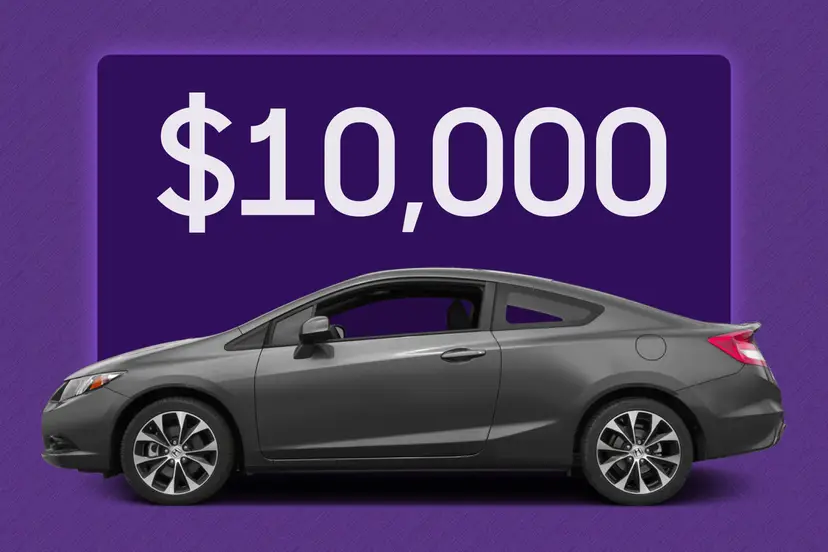
Editor’s note: This review was written in August 2013 about the 2014 Kia Cadenza. Little of substance has changed with this year’s model. To see what’s new for 2015, click here, or check out a side-by-side comparison of the two model years.
Look, Cadenza is a stupid name. But then again, it’s memorable, and so is the new 2014 Kia Cadenza sedan itself, especially if you compare it with the Kia Amanti sold between 2004 and 2009. (I almost forgot about that one myself.)
On its own merits, the 2014 Kia Cadenza is a classy premium sedan, but its status as a Kia rather than a more esteemed brand might make its premium price harder for shoppers to swallow.
Kia has been building some great vehicles over the past several years, including the midsize Optima sedan, which was Cars.com’s car of the year for the 2011 model year. The Cadenza is a full-size sedan. Riding the line between more modest, high-volume cars and full luxury brands, the Cadenza competes with pricier versions of the Buick LaCrosse, Chrysler 300 and Toyota Avalon (see the cars compared side-by-side here). The Cadenza’s higher trim levels nip at the heels of the Volvo S80, the Swedish company’s flagship sedan, though one that’s closer to midsize. If midsize is OK with you, the Lexus ES sedan is a very tough competitor for its quality and starting price of $37,280 (all prices cited include destination charges). The Cadenza starts at $35,900. (See these models compared here.)
Naturally, the Cadenza can’t help but compete with its sister model, the Hyundai Azera (Hyundai owns Kia), with which it shares a platform and most of its hardware. The Hyundai costs $2,755 less.
For a video review, click here.
Exterior & Styling
When viewed from the outside, the Cadenza is a handsome and fairly expensive-looking car. For years, Kias have mimicked Audis. Some of that influence remains in the rear, but the front end now evokes a BMW. (If you’re going to copy other brands, German luxury cars aren’t a bad way to go.) However, I’m disheartened to see the white stripes over the headlight clusters, which I hated on BMWs. It looks like a protective film that should have been peeled off after shipping. On the positive side, when the car’s running, these stripes illuminate and serve as daytime running lights.
The Cadenza measures about 5 inches longer, a half-inch wider and almost an inch taller than the Optima. It’s also a couple of inches longer than the Azera.
In the Cabin
The Cadenza may not be an enormous, rear-wheel-drive sedan, but it’s appropriately larger than the Optima where it counts the most, namely the interior volume. It has 107 cubic feet of interior volume versus 102 in the Optima, 106 in the Chrysler 300 and 102 cubic feet in the LaCrosse.
The Cadenza’s seating dimensions are all equal to or greater than the Optima’s. The biggest difference is in backseat legroom, where the Cadenza has 36.8 inches, which is 2.1 inches more than the Optima. This is an instance where legroom measurements don’t accurately reflect reality. While the LaCrosse measures 40.5 inches and the 300 is 40.1 inches, the Cadenza’s backseat still feels roomy and open. The center floor hump is very low — about ankle-high — which makes the floor space more usable. The 300’s hump is among the highest, at about a foot tall.
The roominess really pays off in accommodating child-safety seats. See the details in our Car Seat Check.
The front occupants enjoy ample room as well, particularly legroom. Nice leather upholstery is standard, and our test car had optional white Nappa leather that felt richer still. Interior quality is always difficult to summarize, because different people value different characteristics. Most of our editors found the materials quality to be appropriate, but one thought the upper doors and some surfaces lower than that seemed cheap. I know this is esoteric, but there’s something about the bright white labels on the buttons that — though legible — makes them look unsophisticated to me.
Some of the features that imparted quality in our test car were options: Along with the Nappa leather in the Luxury Package were a suede ceiling liner and a 7-inch color display between the gauges that presented an analog-style speedometer with additional selectable information screens at its center.
On the Road
Gauging quality is something you also do when in motion. The Cadenza does a decent job of blocking exterior noise, though one of our editors characterized the engine noise as coarse under heavier acceleration. We agreed the ride quality is decent — better than the Optima’s — but it’s certainly not class-leading. Compared with the Chrysler 300, especially, it feels a bit choppy on rough surfaces and firm for a car that otherwise feels like a tourer, not a sport sedan. Without our car’s 19-inch wheels (included with the optional Technology Package), the Cadenza might ride a little bit softer. Eighteen-inch rims are standard.
Equipped with a 293-horsepower, 3.3-liter V-6 engine, the Cadenza feels pretty sprightly, though the six-speed automatic transmission occasionally hesitates when you nail the gas once you’re already in motion. The steering is another attribute that does the job but doesn’t scream performance. The exterior styling might say BMW, but the driving experience says “chill.”
Along with a powerful V-6 comes mileage of 19/28/22 mpg city/highway/combined. Among competitors, it’s about average. Comparing combined mileage, the LaCrosse is rated an estimated 21 mpg, the Chrysler 300 is 18 mpg and the Avalon is 25 mpg. The Azera beats the Cadenza by 1 mpg.
Controls & Operability
Something about building premium or luxury cars inspires automakers to include elaborate interfaces — multifunction rotary knobs/joysticks/buttons or mouselike controllers that don’t necessarily provide clarity or functionality, much less luxury. Despite its effort to break into a higher-rent market, Kia thankfully has not fallen into this trap. The Cadenza is blissfully simple to operate. A thoughtfully selected and arranged set of real buttons provide direct control over the ventilation system. A similarly simple band of buttons below — flanked by two real rotary knobs — lets you access audio sources, music tracks, a Bluetooth-paired phone and the standard navigation system. All these features are displayed on a similarly clearly laid-out 8-inch touch-screen.
Why do other automakers find such simplicity so difficult?
Cargo & Storage
The Cadenza’s cabin has well-sized storage compartments and cupholders, and the trunk is a respectable 15.9 cubic feet. For comparison, the LaCrosse has 10.9 cubic feet (because of the battery for its standard light-hybrid system), the 300 has 16.3 cubic feet and the Avalon has 16.0 cubic feet.
To my disappointment, the Cadenza follows in the style of the Avalon, ES 350 and many full-size luxury cars by excluding a folding backseat. The 300, LaCrosse, S80 and most affordable full-size sedans do include split, folding rear seats to extend trunk space forward.
Safety
In Insurance Institute for Highway Safety testing, the 2014 Cadenza scored very well, with top ratings of Good for frontal, side and rear crash tests and roof-strength tests. Seven of eight competing models subjected to these tests performed the same. (The 2013 Chevrolet Impala, which had two Acceptable scores, has been replaced by a redesigned 2014 that hasn’t been fully tested as of publication.) None of the vehicles in the organization’s Large Family Cars class has undergone the stringent new small-overlap crash test.
In addition to the required antilock brakes and electronic stability system, the Cadenza has eight standard airbags, including seat-mounted side-impact torso bags and side curtains for all outboard occupants, front and rear. A backup camera is also standard.
Two active-safety features, blind spot warning and lane departure warning, are optional in the $3,000 Technology Package. I’m always disappointed to see safety features bundled in high-priced packages with unrelated items. In this case, the package also includes 19-inch wheels, an electronic parking brake, adaptive cruise control and hydrophobic front door windows — the latter a water- and dirt-resistant coating that one could argue has safety advantages. A more affordable safety package would be preferable.
See all the safety features listed here.
Cadenza in the Market
The Cadenza has a decent set of standard features, not the least of which is free scheduled maintenance for the first three years or 37,500 miles — and that’s on top of the above-average five years or 60,000 miles of bumper-to-bumper and roadside-assistance coverage, plus the exceptionally generous 12-year or 100,000-mile drivetrain protection.
But a lot of the items found on the Cadenza that set premium vehicles apart are optional: In addition to the Nappa leather and instrument-panel display mentioned above, the Luxury Package on our car included a powered bottom-cushion extension and ventilation for the standard heated driver’s seat (no ventilation for the passenger), a heated and power-adjustable steering wheel with driver’s seat memory, a power rear-window sun shade and a panoramic moonroof. Our car hit $41,900 as equipped. Checking all the boxes brings it to $42,160.
But the Cadenza meets its main challenge where the Hyundai Azera, Genesis Sedan and Equus have: providing the additional allure for which luxury-car buyers pay a premium. For example, apart from its smaller size, the Lexus ES 350 is surprisingly close to the Cadenza in its standard-features list, though glaring differences include the Lexus’ standard vinyl upholstery and shorter warranties (except corrosion/perforation). What it has, however, is the Lexus name.
The Cadenza’s features and quality are comparable to — and in some cases are more generous than — competitors, but true luxury vehicles command money for a perception of value associated with the brand. Such perceptions of value are unquantifiable and perplexingly unpredictable from one shopper to the next. As long as the Cadenza and its Hyundai counterparts are sold under the same brand name as the companies’ modest models, they’ll struggle to imply any value beyond what they offer in features and quality.
| Send Joe an email |




















































